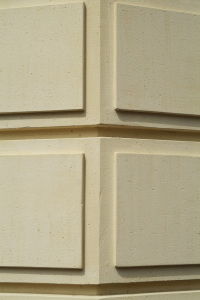Jointing methods


Description
- Dug joints can make various motifs in the coating, typically in imitation of jointed stone or brick.
- Jointing can begin two days after set, dug with the aid of a tool, chemin de fer.
- They can be left hollow (English style, generally associated with exteriors) or refilled with a white plaster (French Style, more in keeping with interiors). In the latter case, the entire surface is recut with a sharpened berthelet, large chemin de fer or sanded after thoroughly drying (80 grit) ensuring clean white joints.
- Sometimes only horizontal joints are cut usually left hollow.
Tips
- Horizontal joints can be dug by machine.
- Chalk line the entire pattern before starting to dig in order to ensure proper distribution of the joints.
- Apart from traditional stuc pierre or stuc brique applications, many designs are possible with curved joints or even dug motifs refilled with white plaster, tinted to match the background or a contrasting color. In this way flat surfaces can be created with contrast in design utilizing various colors. If the motifs are left hollow or “intaglio”, a contrasting sunken relief of the same color is created.
Tools
- Custom width chemin de fer, French joint cutting tool
- Berthelet or large chemin de fer
- Sander
- Straight edge
- Laser level
- Chalk box
Videos
See : How to make a stuc brique ?